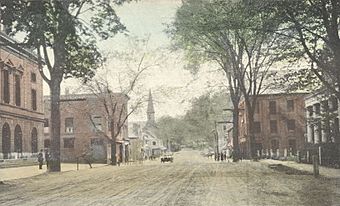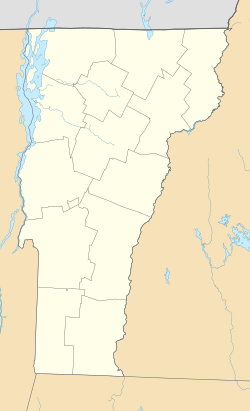Windsor Village Historic District (Windsor, Vermont) facts for kids
|
Windsor Village Historic District
|
|

Main Street on a 1910 postcard
|
|
| Location | Center of Windsor, Vermont |
|---|---|
| Area | 50 acres (20 ha) (original) 1.2 acres (0.49 ha) (size of 1997 increase) |
| NRHP reference No. | 75000212 (original) 97000828 (increase 1) 14001036 (increase 2) |
Quick facts for kids Significant dates |
|
| Added to NRHP | April 23, 1975 |
| Boundary increases | July 25, 1997 December 1, 2014 |
The Windsor Village Historic District is a special area in the middle of Windsor, Vermont. It's like a living museum, filled with many old buildings from the 1700s, 1800s, and early 1900s. These buildings show off different styles of architecture from those times. This historic district is so important that it was added to the National Register of Historic Places on April 23, 1975.
The district first included buildings along Main Street, Depot Avenue, and State Street, including Court Square. Later, more buildings on Phelps Court were added. The district has been made larger a few times to include even more historic spots.
Contents
History of Windsor Village
How Windsor Became Important
In 1777, a very important event happened in Windsor. At the Old Constitution House, which is part of this historic district, leaders wrote the first constitution for the Vermont Republic. This meant Vermont became its own independent area for a while, before joining the United States.
Windsor was even the part-time capital of the Vermont Republic. It also became the main town for Windsor County. These important roles brought many people to the town, including educated professionals.
Growth and Industry
Windsor is located right next to the Connecticut River. This river made it easy to transport goods and people. In 1847, a railway was built, which made transportation even better.
During the 1800s, Windsor grew into a busy place with lots of factories and offices. This led to many new buildings being constructed. Factories and businesses were mostly found on Main Street and Depot Avenue, including the railway station. Homes were built on State Street and the northern part of Main Street. By the late 1800s, Windsor's main industries made things like water pumps, firearms, and machine tools.
Historic Buildings in the District
The Windsor Village Historic District includes many interesting buildings. These buildings show different styles of architecture from the past. Some popular styles you might see are Federal, Queen Anne, Gothic Revival, and Italianate.
The district has been expanded over the years to protect more of these special places. For example, in 1997, three more buildings on Phelps Court and State Street were added. It was made even larger in 2014.
Some of the notable buildings in the district include:
- The Old Constitution House: This is where Vermont's constitution was written in 1777.
- The Jesse Lull House: Built in 1806, it's an example of Federal style architecture.
- The Central Vermont Railway Station: This building from around 1905 shows the Romanesque style.
- The Windsor Municipal Building (also known as the Windsor Fire Station): Built in 1929, it features Georgian Revival architecture.
- The Old South Congregational Church: Constructed in 1798, it's a Federal style church that has been rebuilt several times.
- The McIndoe House: This house from 1840 is an example of Gothic Revival style.
- The Windsor House: Built in 1836, this building shows the Greek Revival style.
- The Abner Forbes House and Zebina Curtis-William Maxwell Evarts House: Both built in 1796, these houses are examples of Federal and Georgian styles.
- The John Skinner House, Joseph Hatch (Edminster) House, and Simeon Ide House: These Federal style homes were built around the 1820s.
These buildings help tell the story of Windsor's past, from its early days as a political center to its growth as an industrial town.
Images for kids














